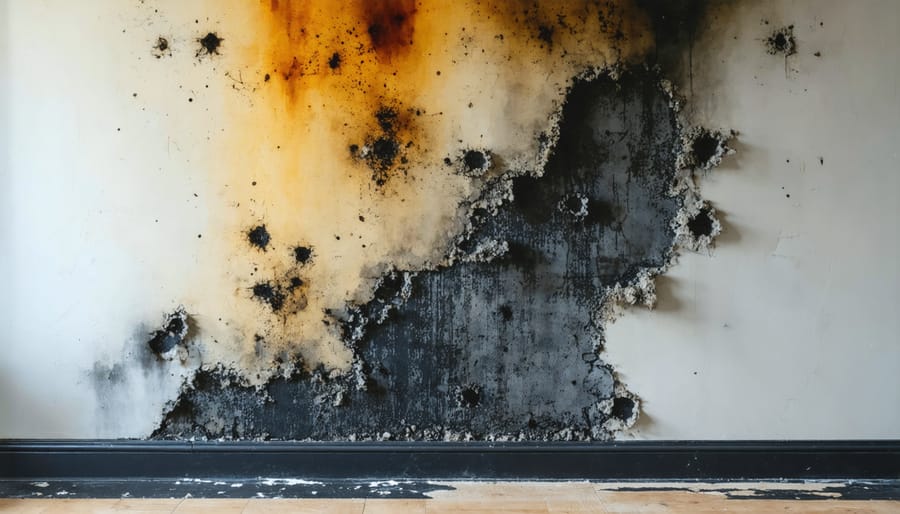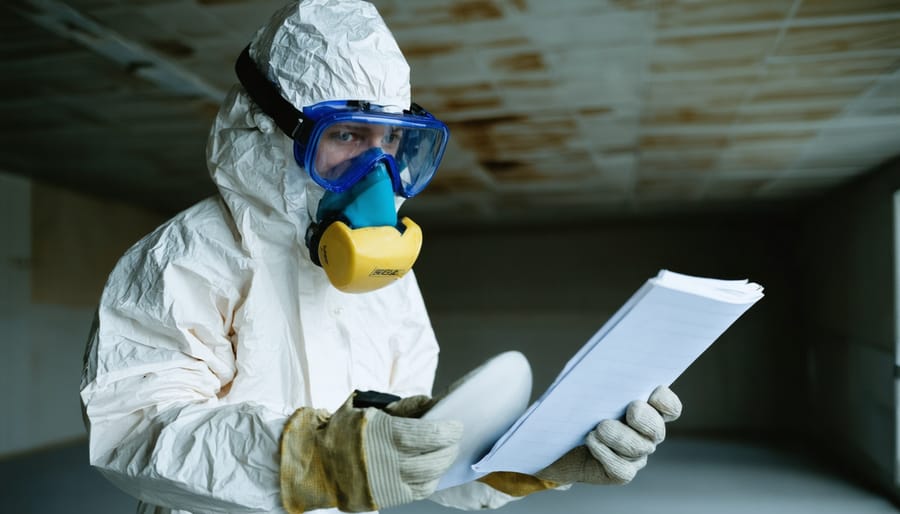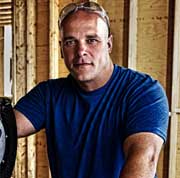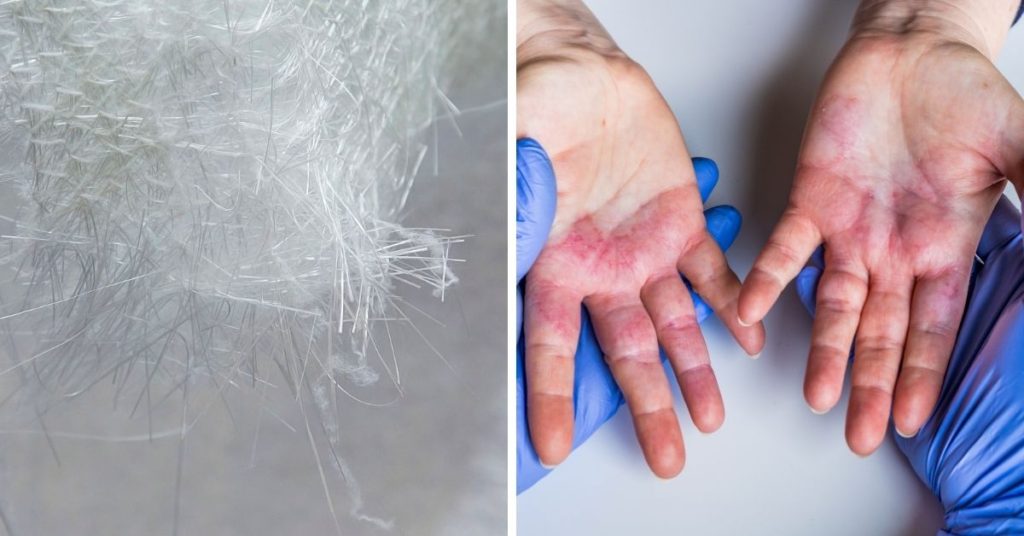Discovering mold in your home demands immediate action, but choosing between mitigation and remediation can mean the difference between a temporary fix and a lasting solution. While mitigation focuses on controlling existing mold growth and preventing its spread, remediation involves completely removing the problem at its source. When dealing with older homes, particularly those built before 1980, the stakes become even higher as disturbing mold-affected materials could release dangerous asbestos fibers into the air.
Understanding these distinct approaches isn’t just about terminology – it’s about protecting your family’s health and your property’s value. Mitigation might seem like an attractive quick fix, involving containment and moisture control, but remediation’s comprehensive approach addresses the root cause by removing contaminated materials and preventing future growth. For homeowners facing this crucial decision, particularly in properties where asbestos may be present, the choice between these methods requires careful consideration of safety protocols, long-term effectiveness, and potential health risks.
Let’s explore why these approaches differ, when each is appropriate, and how to make the safest choice for your specific situation.

Understanding Mold Mitigation: The First Line of Defense
Key Components of Mold Mitigation
Successful mold mitigation relies on several key components that work together to prevent and contain mold growth. First, moisture control is essential – this means fixing leaks, improving ventilation, and maintaining proper humidity levels (ideally between 30-50%). Installing dehumidifiers and ensuring adequate air circulation can make a significant difference in preventing mold from taking hold.
Proper containment is another crucial element, involving physical barriers like plastic sheeting to isolate affected areas and prevent spores from spreading to clean spaces. Air filtration devices with HEPA filters help capture airborne spores, while negative air pressure systems ensure contaminated air doesn’t escape the work area.
Regular inspections play a vital role in early detection. Keep an eye on common problem areas like bathrooms, basements, and around windows. Quick response to water damage is also critical – addressing moisture issues within 24-48 hours can prevent mold from establishing itself.
Lastly, maintaining clean gutters, proper grading around your foundation, and ensuring adequate ventilation in crawl spaces and attics are preventive measures that can save you from major mold headaches down the road.
When Mitigation Is Enough
Sometimes, mold issues don’t require extensive remediation efforts, and mitigation alone can effectively solve the problem. This is typically the case when you’re dealing with small, surface-level mold growth (less than 10 square feet) in easily accessible areas. For instance, if you spot mold on bathroom tiles or windowsills due to condensation, a thorough cleaning with appropriate cleaning solutions might be all you need.
Mitigation is also sufficient when the moisture source has been quickly identified and fixed before the mold had a chance to penetrate deeper into building materials. Think of a recent pipe leak that was promptly repaired, causing only surface mold on drywall. In these cases, drying the area and cleaning the affected surface can prevent further growth.
Another scenario where mitigation works well is when dealing with seasonal humidity issues. Installing a dehumidifier and improving ventilation can often resolve minor mold problems without the need for extensive remediation work. Just remember – if you’re unsure about the extent of the problem or if you have underlying health concerns, it’s always better to consult a professional for guidance.
Mold Remediation: The Complete Solution

Professional Remediation Steps
Professional remediation follows a strict, systematic approach to ensure complete mold removal and prevent future growth. The process begins with a thorough inspection and assessment, where specialists document the extent of contamination and identify potential moisture sources. They’ll then establish containment barriers using heavy-duty plastic sheeting and implement negative air pressure to prevent spores from spreading to unaffected areas.
Safety is paramount during remediation. Professionals wear appropriate personal protective equipment (PPE), including N-95 respirators, full-body suits, and eye protection. They use HEPA air filtration devices to capture airborne spores and specialized cleaning agents to treat affected surfaces.
The actual removal process involves carefully removing contaminated materials, such as drywall, insulation, or carpeting. These materials are sealed in heavy-duty bags before disposal. The exposed areas are then thoroughly cleaned using HEPA vacuums and antimicrobial solutions. After cleaning, the space is dried completely using professional-grade dehumidifiers and air movers.
Final steps include post-remediation verification testing to ensure all mold has been successfully removed and addressing the root cause of moisture to prevent future issues. This might involve repairing leaks, improving ventilation, or upgrading insulation.
Special Considerations with Asbestos
When dealing with mold in older homes, the presence of asbestos adds an extra layer of complexity to the situation. Asbestos, commonly found in buildings constructed before the 1980s, can be disturbed during mold removal processes, creating a serious health hazard. This is why it’s absolutely crucial to have your property tested for asbestos before beginning any mold-related work.
If asbestos is detected, you’ll need to engage in professional asbestos removal services before addressing the mold issue. Never attempt to handle both problems simultaneously on your own, as this could release dangerous asbestos fibers into the air.
The key safety measures include:
– Having a certified inspector test for asbestos
– Ensuring proper containment of both substances
– Using appropriate protective equipment
– Following strict disposal protocols
– Maintaining proper documentation
Remember, while mold remediation might seem straightforward, the presence of asbestos transforms it into a complex operation requiring specialized expertise. Your safety and that of your family should always come first, even if it means taking additional time and incurring extra costs to address both issues properly.
Making the Right Choice: Mitigation or Remediation?
Assessment Criteria
When deciding between mold mitigation and remediation, several key factors come into play during your home safety assessment. First, evaluate the extent of mold growth – if it covers less than 10 square feet, mitigation might be sufficient. However, larger areas typically require full remediation.
Consider the type of mold present – some varieties are more hazardous than others. Black mold, for instance, often demands complete remediation due to its health risks. The location matters too – mold in living spaces or near HVAC systems poses greater risks than mold in less-frequented areas.
The underlying cause is crucial – if there’s ongoing water intrusion or humidity issues, simple mitigation won’t solve the problem long-term. Also, check the affected materials – porous surfaces like drywall or carpeting usually need removal and replacement through remediation, while hard surfaces might respond well to mitigation efforts.
Finally, consider your budget and timeline. While mitigation is generally less expensive and faster, choosing this option when remediation is needed could lead to recurring problems and higher costs down the road.
Cost Comparisons
When it comes to your wallet, there’s a significant difference between mold mitigation and remediation costs. Mitigation typically ranges from $500 to $1,500 for an average-sized room, focusing mainly on preventing moisture and addressing minor mold issues. This might include installing dehumidifiers, fixing leaks, and applying preventive treatments.
Remediation, on the other hand, can be a much bigger investment, typically starting at $2,000 and potentially reaching $6,000 or more for extensive cases. This higher cost reflects the comprehensive nature of the work: removing damaged materials, cleaning hidden areas, and ensuring proper disposal of contaminated items.
Keep in mind that these costs can vary based on several factors:
– Size of the affected area
– Location of the mold (attic vs. basement)
– Type of materials involved
– Presence of additional issues like water damage
– Local labor rates
While mitigation might seem like the budget-friendly choice, it’s important to consider long-term implications. Choosing mitigation when remediation is needed could lead to recurring problems and higher costs down the road. Remember, the cheapest option isn’t always the most cost-effective in the long run.
Safety First: Professional Help vs. DIY
When it comes to mold issues, knowing when to DIY and when to call the professionals can make the difference between a successful cleanup and a potential health hazard. As a general rule, if the affected area is smaller than 10 square feet and doesn’t involve sewage or potentially toxic materials, you might be able to handle it yourself.
For DIY-safe situations, homeowners can tackle surface mold on non-porous materials using appropriate protective gear (N-95 mask, gloves, and eye protection) and household cleaning solutions. This might include cleaning small patches of bathroom mold or addressing minor window condensation issues.
However, certain scenarios absolutely require professional intervention:
– Mold covering areas larger than 10 square feet
– Contamination within HVAC systems
– Water damage from contaminated water
– Suspected presence of toxic black mold
– Any situation involving asbestos-containing materials
– Hidden mold behind walls or under carpets
As you prepare your home for emergencies, remember that professional mold remediation specialists have specialized equipment, proper training, and experience in containing mold spread. They can also perform necessary testing to identify the type of mold and ensure complete removal.
Never attempt to handle mold situations if you have respiratory issues or compromised immunity. When in doubt, it’s always better to consult professionals – the cost of proper remediation is far less than the potential health risks and property damage from improper handling.
Prevention and Long-term Management
Preventing future mold growth in homes with asbestos materials requires a strategic approach that balances effective moisture control with safe handling practices. The key is to protect your home by maintaining proper ventilation and addressing water issues promptly.
Start by installing and maintaining dehumidifiers in areas prone to moisture, keeping indoor humidity levels between 30-50%. Consider upgrading your ventilation system with humidity-controlled fans in bathrooms and kitchens, being careful not to disturb any existing asbestos materials during installation.
Regular inspections are crucial but should be done visually without disturbing suspicious materials. Create a maintenance calendar to check for water stains, condensation, or musty odors – early warning signs that could indicate developing problems. Pay special attention to areas around windows, pipes, and roof connections where water might intrude.
For long-term management, consider applying moisture-resistant coatings to walls and surfaces that don’t contain asbestos. Keep gutters clean and ensure proper drainage around your foundation. If you have asbestos-containing materials that are in good condition, it’s often safer to leave them undisturbed and focus on controlling environmental factors that promote mold growth.
Remember to maintain detailed records of any moisture issues, repairs, or modifications made to your home. This documentation helps track problem areas and proves valuable if professional intervention becomes necessary. When in doubt about whether a surface contains asbestos, always consult a certified professional before attempting any modifications or repairs that might disturb these materials.

When dealing with mold issues in your home, understanding the distinction between mitigation and remediation is crucial for making informed decisions. As we’ve explored, mitigation focuses on preventing further spread and addressing immediate concerns, while remediation involves comprehensive removal and restoration of affected areas. Both approaches serve different purposes and may be appropriate depending on the extent of your mold problem.
Remember, proper assessment is the cornerstone of successful mold treatment. While minor issues might be suitable for DIY mitigation efforts, extensive mold growth, especially when combined with potential asbestos concerns, requires professional expertise. Don’t hesitate to consult qualified specialists who can accurately evaluate your situation and recommend the most appropriate course of action.
Whether you choose mitigation or remediation, prioritizing safety and thorough treatment will protect both your home’s integrity and your family’s health. Regular maintenance and moisture control after treatment will help prevent future mold issues, making your investment in professional services worthwhile. By taking these considerations seriously and acting promptly, you’ll be well-equipped to handle any mold challenges that come your way.










